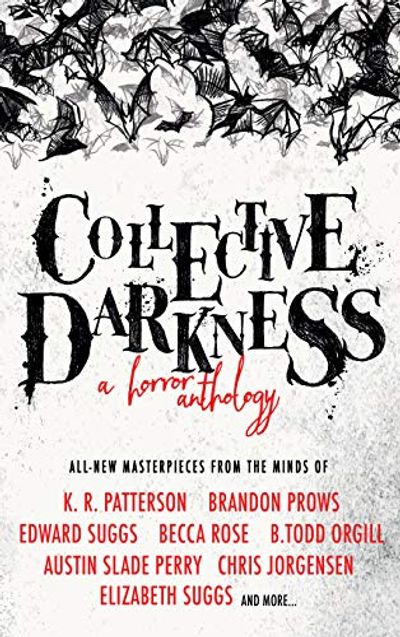Collective Darkness, edited by Elizabeth Suggs
Collective Darkness is an eclectic assemblage of twelve tales that knock about the realm of dark fiction, from psychological horror to dark fantasy. There is something in this book for every spooky story aficionado, and I found myself surprised and delighted at both the originality of some of these creepy yarns and my gravitation toward pieces in sub-genres I don’t normally enjoy.
One of the more original stories is K. R. Patterson’s “Red Flag,” snagging the reader from the get go with the line, “Shane told me he’s going to kill somebody.” From the time when he was just a toddler, a son’s insidiously matter-of-fact declarations make his mother, the story’s primary narrator, concerned about the sociopathy she sees growing within him. The narrator does not want to “betray” her child by notifying the authorities, but her interaction with outside sources makes her question her judgement. The road Patterson chooses to lead the reader is a well-tread one—the “Good Son” trope is one that seems only to have proliferated with the advent of school shootings—however, where she leads the reader from there is quite unique, and the story kept me rapt until the very end.
“Pond Scum” by Alex Child proves that metaphorical darkness can be stronger than any visual cloak. I don’t recall Child specifically stating the season in which his no-longer-coming-of-age tale takes place, but I imagine it was late summer when Isaac and Corey bypassed the fence and warning signs posted around the “sickle-shaped pond” and explored its nefarious secrets. What occurs there is delightfully disturbing in a plot twist akin to Stephen King’s “The Raft.” Read this one the next time you’re at the lakeside retreat with the family.
What surprised me was the story I enjoyed the most of the twelve: “The Figure in the Mirror” by Brandon Prows. An expertly crafted hybrid of psychological and cosmic horror, its plot arc can only be compared to one of a roller-coaster slowly ascending an incline, the view in front obscured from its passengers until the moment the car drops; then, the twisting descent pulls the car’s passengers into paranoid confusion and screaming terror. Asher returns to his hometown of Hornwood to visit his grandfather’s property. But as he’s welcomed home with a series of strange occurrences—a desperate stranger handing him a flyer on a missing child, a gash in his forehead he doesn’t remember getting, a subtly unnerving gathering of townsfolk—Asher begins to suspect there’s something very different about the Hornwood he abandoned years ago: something different…and deadly. I’ve never been fond of folk horror, but Prows has single-handedly converted me. Furthermore, despite being the lengthiest story in the anthology, “Figure” does not drag or waste words. Bravo to Prows for conjuring the love child of Shirley Jackson and HP Lovecraft.
Although not all of the tales resonated with me, I did not find a true weak link in the bunch; rather, editor Suggs offers a solid variety of styles and sub-genres for her readers to devour. My only criticism is of the number of pages devoted to an Introduction, a Foreword, and an Editor’s note; with a collection this slim, the space would have been better served featuring another piece of fiction and the musings over the experience shared in a blog post or podcast interview about the book. Overall, Collective Darkness makes good on its promise. As suggested in the editor’s own tale, the final in the anthology, “You can’t hide forever. Not from Hell. Not from me,” darkness will be found in the most innocuous of places, and its chameleonic nature is illuminated by these twelve craftsmen.
